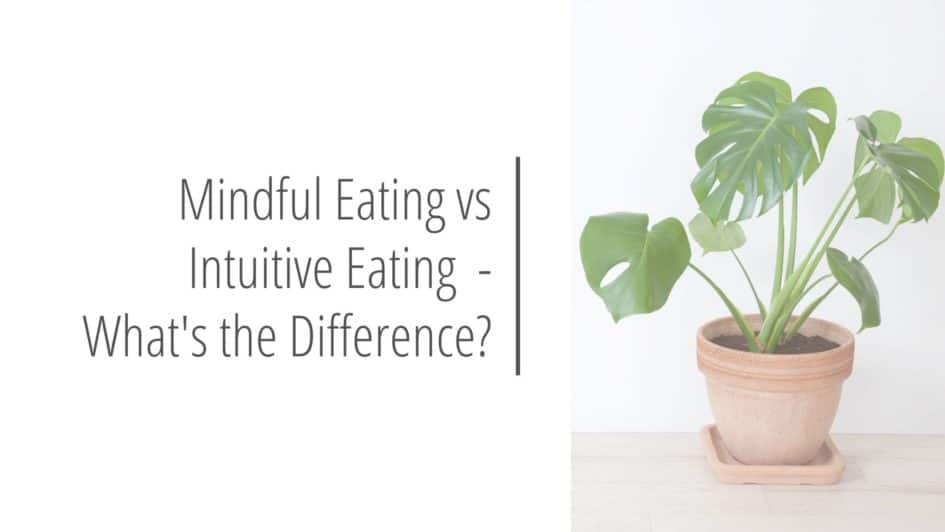Table of Contents
Mindful Eating vs Intuitive Eating
Mindful eating vs Intuitive Eating. Is there a difference?
Within the anti-diet community, the terms mindful eating and Intuitive Eating get thrown around quite a bit. If you’re unfamiliar with these terms, it can be easy to get the two confused. If you want to learn the difference between them, you’re in the right place!
What is Intuitive Eating?
To understand mindful eating vs Intuitive Eating, it’s important to directly contrast the two. First, let’s talk about Intuitive Eating.
For an in-depth explanation of Intuitive Eating (IE), head over to my post 10 Principles of Intuitive Eating – A Non-Diet Approach to Health. For a brief introduction, stay here!
A Non-Diet Framework
Intuitive Eating (IE) is an evidence-based, holistic approach to health. It was created by two registered dietitians (RDs), Evelyn Tribole and Elyse Resch. It serves as a non-diet, weight-neutral approach to developing a healthy relationship with food and body. The goal is to pursue true overall health and wellness.
Intuitive Eating has 10 core principles. These principles are to be looked at as guidelines, not rules. Intuitive Eating is not another diet and you can’t fail Intuitive Eating.
10 Core Principles of IE
1. Reject the Diet Mentality
2. Honor Your Hunger
3. Make Peace with Food
4. Challenge the Food Police
5. Feel your Fullness
6. Discover the Satisfaction Factor
7. Cope With Your Emotions With Kindness
8. Respect Your Body
9. Movement – Feel the Difference
10. Honor Your Health – Gentle Nutrition
This is only a very brief explanation of Intuitive Eating. If you want to begin your Intuitive Eating journey, I suggest you read the newest version of Intuitive Eating (4th Edition), which can be found where books are sold.
What is Mindful Eating?
Mindful eating isn’t a framework that was created by dietitians. It is more of a philosophy or a mindset. According to the Center for Mindful Eating, there are 5 principles of mindfulness.
Principles of Mindfulness
- Mindfulness is choosing to pay attention, in a non-judgmental fashion
- Mindfulness involves both internal and external processes
- Mindfulness is being aware of your presence in each moment mentally, emotionally, and physically
- Mindfulness can free you of habitual thinking, feeling, and acting
- Mindfulness instills balance, choice, wisdom, and acceptance of what is
In addition to the principles of mindfulness, the Center for Mindful Eating discusses what mindful eating is and how someone eats mindfully.
Examples of Mindful Eating
- Being aware of the nourishing capabilities of food preparation and consumption
- Choosing foods that are both pleasing and nourishing to the body
- Being non-judgmental towards personal likes and dislikes towards foods
- Being aware of physical hunger and satiety cues to help guide eating
- Acknowledging that there is no right or wrong way to eat
- Accepting that each individual’s eating experience is unique
- Directing awareness to all aspects of food while eating
- Being aware of the effects of unmindful eating
- Enjoying the taste, smell, mouthfeel, and appearance of each food consumed
Quick Summary
When it comes to mindful eating vs Intuitive Eating, is there a difference?
Yes, there is definitely a difference between Intuitive Eating and mindful eating.
Intuitive Eating is a non-diet framework created by dietitians to improve one’s relationship with food and body. On the other hand, mindful eating isn’t a framework by itself, but it can be used in correlation with Intuitive Eating.
For example, mindful eating can assist with several IE principles including Discover the Satisfaction Factor, Honor Your Hunger, and Feel Your Fullness. With this said, Mindful Eating can be thought of as a strategy or “tool in your toolbox” while Intuitive Eating is an evidence-based, holistic approach to health.
Additionally, since mindful eating isn’t a framework by itself, it can be added to any form of eating, such as mindful eating while on the keto diet, Whole30, intermittent fasting, etc.
However, Intuitive Eating cannot be added to just any form of eating because Intuitive Eating is a form of eating on its own. Intuitive Eating can’t be added to the keto diet, Whole30, intermittent fasting, or any other diet because that goes against the very core of Intuitive Eating and what it stands for.
I hope this helped you better understand mindful eating vs Intuitive Eating! Check out my website for more information on Intuitive Eating, Health at Every Size (HAES), body positivity, and all things anti-diet.
Thanks for reading!
Rachel Beiler, MHS, RD, LDN
References
Intuitive Eating: A Revolutionary Anti-Diet Approach, 4th Edition by Evelyn Tribole & Elyse Resch


Leave a Reply